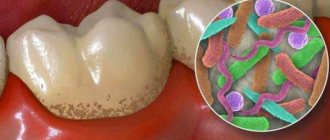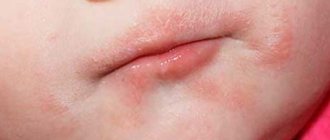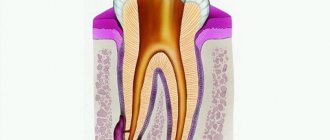Author of the article:
Soldatova Lyudmila Nikolaevna
Candidate of Medical Sciences, Professor of the Department of Clinical Dentistry of the St. Petersburg Medical and Social Institute, Chief Physician of the Alfa-Dent Dental Clinic, St. Petersburg
The human oral cavity has its own microflora and its own specific diseases arise. Let's talk about one of them - fibrous epulis of the gums: what kind of disease it is, what are the causes of its occurrence, how is the treatment carried out.
What it is
Epulis is a tumor-like neoplasm that develops on the alveolar process of the jaw. It also has other names - epulid, supragingival, giant cell granuloma. More often it is localized in the area of incisors, canines and small molars of the upper jaw, less often the tumor is detected in the lower jaw. The growth has a round or irregular shape and a wide stalk; the size of the formation varies from 3 mm to 5 cm.
Despite the fact that such a tumor looks frightening, it practically does not cause concern to the patient, unlike, for example, a burn, with the exception of a violation of aesthetics and the sensation of a foreign body in the oral cavity. Large tumors may cause difficulty chewing and swallowing food.
If epulis is accompanied by bleeding, infection may occur, which will lead to complications.
The disease mainly affects adults, but the neoplasm can also appear in children; in the latter, it occurs during teething. Studies have shown that women are more susceptible to developing epulis than men.
Dentists' recommendations
Epulis is a gum tumor that poses a great danger to the health of teeth and the entire body. Treatment of the pathology is complex and lengthy, but even with high-quality treatment, the risk of relapse cannot be ruled out.
It is not always possible to prevent the occurrence of epulis on the gums of a child or an adult, but with timely consultation with a specialist, complications, complex treatment, long recovery and aesthetic defects that remain after surgery can be avoided.
The best prevention is to visit the dentist every 6 months. If you are concerned about discomfort and a feeling of rubbing of the mucous membranes or gums, you should immediately consult a dentist, without waiting for a tumor or other pathologies to occur.
Varieties of epulis
Conventionally, there are 3 types of epulis:
- Fibrous. The neoplasm is dense, the basis is coarse fibrous tissue. Characterized by slow growth. There is no pain or bleeding.
- Angiomatous. The tumor contains a large number of blood vessels and is localized mainly in the lateral parts of the jaw. With this form of the disease, bleeding is observed even with slight pressure, for example, with a toothbrush or food. When pressed, the tumor is painless and has a soft consistency.
- Giant cell. The tumor can reach large sizes, displacing teeth that are located in the epulis growth zone. The mucous membrane of the epulis is bluish-red in color. On palpation, the neoplasm is painless, but may bleed moderately if injured.
Depending on the nature of the process, epulis can be benign or malignant. In the first case, the neoplasm is characterized by slow development and, as mentioned above, in most cases does not cause pain. The tumor size in this case rarely exceeds 10–20 mm. When the process becomes malignant, rapid tissue growth is observed. In this case, the process is often accompanied by pain, bleeding gums and affects the root canals of neighboring teeth.
Diagnosis and treatment of epulis
Diagnosis of epulis comes down to collecting complaints, clinical examination, radiography and histological examination of the material.
The primary task in making such a diagnosis is to eliminate the provoking factor: professional cleaning of dental plaque, treatment of caries and its complications, replacement or correction of orthopedic structures according to indications. In fibromatous and angiomatous forms, dynamic observation is indicated, since after sanitation of the oral cavity and elimination of the causes of the disease, the tumor may decrease in size until it disappears completely.
Treatment of epulis is carried out surgically. The growth on the gum under local anesthesia or general anesthesia is excised with a scalpel or laser within the healthy tissue along with the periosteum. The second method is preferable, since the laser simultaneously coagulates the vessels and stops bleeding. With giant cell epulis, the area of bone tissue involved in the process is also removed. To do this, use a bur or cutter. The wound is closed with gauze with an iodoform mixture or a formed mucoperiosteal flap. If necessary, the material is sent for histological examination.
Intact teeth in the area of tumor localization must be removed with a high degree of mobility and severe exposure of the roots. If the bone lesion is extensive or epulis recurs, partial resection of the alveolar part along with the teeth is performed.
To speed up the healing of a fresh wound, the doctor prescribes compresses with medicinal ointments and rinses to the patient.
Symptoms of the problem
You should consider the main diseases that cause redness of the gums and their distinctive signs:
Causes of gum inflammation
- Gingivitis. The disease is associated with damage to the tissue near the tooth by harmful agents. The main cause of the problem is improper oral care. Untreated gingivitis is complicated by periodontitis or periodontal disease, and tooth loss. The main signs are pain when eating and brushing teeth, bad breath, and fever.
- Periodontitis. In pathology, the soft tissues around the tooth are affected. The disease is acute with pronounced symptoms, as well as changes in pain intensity. The pathological process develops within 7-14 days. If not treated in a timely manner, periodontitis can lead to heart attack, stroke, loss of dentition, and intoxication of the body.
- Periodontal disease. During the disease, the tissues surrounding the teeth also become inflamed. A distinctive feature of the pathology is sluggish development. The problem occurs with hidden symptoms for several years, but ultimately leads to the loss of units. The main signs of periodontal disease: unsteadiness of elements, red growths on the gums, divergence of teeth in different directions. Untimely treatment of periodontal disease can lead to diseases of the gastrointestinal tract due to inadequate chewing of food.
Preventive actions
Monitoring the condition of the teeth and oral cavity will reduce the likelihood of tumors.
- Timely sanitation of the oral cavity. Visiting the dentist for a preventive examination and professional hygiene twice a year will prevent the growth of caries, the appearance of defects in fillings and the formation of tartar, leading to gum injury and the appearance of epulis.
- Prevention of gum injury. If systematic injury to soft tissue occurs as a result of poorly fitted orthopedic or orthodontic structures, consult your doctor about this problem. He will adjust the crowns or dentures.
If these preventive measures are followed, the prognosis is favorable and epulis does not recur.
We hope that our article about epulis will be for informational purposes only. And if you want to soothe your gums, make them strong and strong, try the unique two-component mouth rinse ASEPTA ACTIVE.
This is the only rinse with a combination of chlorhexidine + benzydamine for the treatment of inflammatory periodontal diseases. The product has a combined effect: antimicrobial, anti-inflammatory and analgesic. Instant anesthetic effect allows you to quickly reduce pain.
Emergency help for inflammation
What to do if your gums hurt? First aid to relieve symptoms is provided at home. It is recommended to regularly (once every 2 hours) rinse your mouth with antiseptic solutions - furatsilin, baking soda, chlorhexidine.
To treat redness of the gums, ointments with an antiseptic and hemostatic effect are used.
The basic rule of emergency care is the exclusion of radical methods of treatment: such therapy leads to serious consequences. To stop the proliferation of pathogenic flora, herbal tinctures sold in pharmacies without a prescription are suitable - Givalex, Stomatodin, Mevalex. The products are used according to the instructions for use.
Clinical researches
Repeated clinical studies have proven that the two-component mouth rinse ASEPTA ACTIVE more effectively combats the causes of inflammation and bleeding compared to single-component rinses - it reduces inflammation by 41% and reduces bleeding gums by 43%.
Sources:
- Clinical and laboratory assessment of the influence of domestic therapeutic and prophylactic toothpaste based on plant extracts on the condition of the oral cavity in patients with simple marginal gingivitis. Doctor of Medical Sciences, Professor Elovikova T.M.1, Candidate of Chemical Sciences, Associate Professor Ermishina E.Yu. 2, Doctor of Technical Sciences Associate Professor Belokonova N.A. 2 Department of Therapeutic Dentistry USMU1, Department of General Chemistry USMU2
- The effectiveness of the use of Asept “adhesive balm” and Asept “gel with propolis” in the treatment of chronic generalized periodontitis and gingivitis in the acute stage (Municipal Dental Clinic No. 4, Bryansk, Kaminskaya T. M. Head of the therapeutic department Kaminskaya Tatyana Mikhailovna MUZ City Dental Clinic No. 4, Bryansk
- Study of the clinical effectiveness of treatment and prophylactic agents of the Asepta line in the treatment of inflammatory periodontal diseases (A.I. Grudyanov, I.Yu. Aleksandrovskaya, V.Yu. Korzunina) A.I. GRUDYANOV, Doctor of Medical Sciences, Prof., Head of Department I.Yu. ALEXANDROVSKAYA, Ph.D. V.Yu. KORZUNINA, asp. Department of Periodontology, Central Research Institute of Dentistry and Maxillofacial Surgery, Rosmedtekhnologii, Moscow
- The role of anti-inflammatory rinse in the treatment of periodontal diseases (L.Yu. Orekhova, A.A. Leontyev, S.B. Ulitovsky) L.Yu. OREKHOVA, Doctor of Medical Sciences, Prof., Head of Department; A.A. LEONTIEV, dentist; S.B. ULITOVSKY, Doctor of Medical Sciences, Prof. Department of Therapeutic Dentistry of St. Petersburg State Medical University named after. acad. I. P. Pavlova
How to treat swollen gums
Treatment of inflamed gums begins with identifying the cause of the disease. To do this, an X-ray of the jaw and an examination of the oral cavity are performed.
Further tactics depend on the established diagnosis. If surgical intervention is necessary (opening an abscess, removing a cyst), it is performed immediately. The patient is anesthetized in the dentist's chair, and then all necessary manipulations are performed.
After surgical treatment, maintenance drug therapy is prescribed. It allows you to avoid the development of complications. Most often, the patient is prescribed rinsing with an antiseptic solution and taking anti-inflammatory drugs. Antibiotics are sometimes recommended to prevent bacterial complications. They should be taken only as prescribed by a doctor, and exactly the drug that is indicated in the prescription. This is important to achieve a guaranteed positive effect.
Some drugs do not combine with each other. Therefore, uncontrolled use of medications can harm the patient himself. If you choose the wrong antibiotic, the bacteria will not only not die, but will also develop resistance to the drug. Then it will take a long time to select a suitable remedy, which will complicate the patient’s life - it will no longer be possible to quickly get rid of unpleasant symptoms.
Rinse recipes
The patient's attending physician should prescribe rinses. They are not allowed for all diseases. After surgical treatment, rinsing too hard can cause the suture to come apart. An infection or food particles will get into an open wound, which will cause new inflammation and suppuration.
It is impossible to completely cure swollen gums with rinses. But they are advised to be combined with drug treatments to alleviate the condition and enhance the effect of the drugs.
- Decoctions of medicinal herbs: chamomile, calendula, lemon balm, sage, St. John's wort. Some components can cause allergies, so you need to be careful with them. However, they have a mild anti-inflammatory effect and can help relieve swelling and reduce inflammation.
- Propolis tincture - dilute it with warm water and rinse your mouth 2 times a day. The product helps against ENT diseases (sore throat and sinusitis), which often develop into inflammation of the gums.
- Soda and salt - add 1 teaspoon of each powder to a glass of warm water and stir. The product has a wound healing effect and helps stop bleeding gums.
In addition to rinsing, lubricating the area of inflammation with tea tree or fir oil is also effective. They have an anti-inflammatory and wound-healing effect. However, they should not be applied to the site of suppuration. It is also worth considering the risk of plant allergies.
There are many reasons for gum swelling, not all of them are obvious. Only a doctor after diagnosis can figure out what caused the inflammation. Independent attempts to cure the disease often lead to serious complications, so you should not expect that the swelling on the gums will go away on its own. It is better to visit a doctor and make sure there are no risks or get competent and timely treatment.










